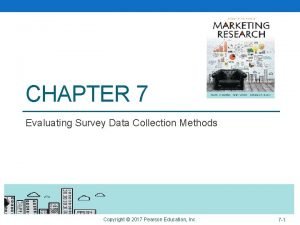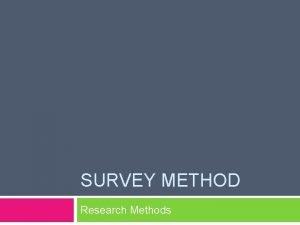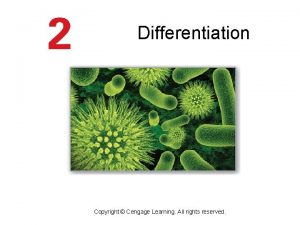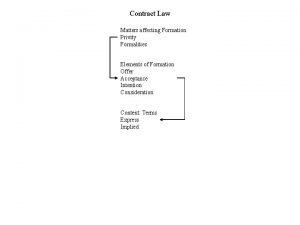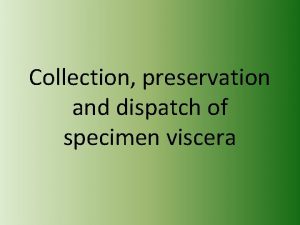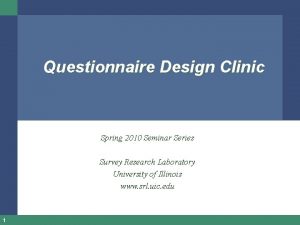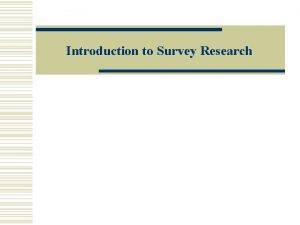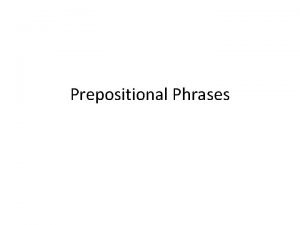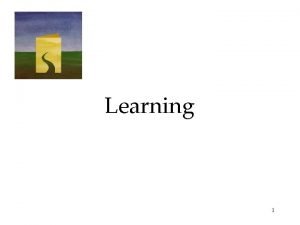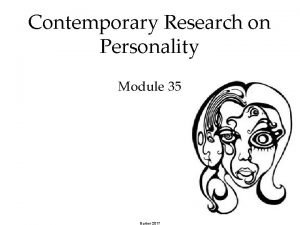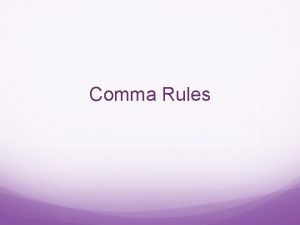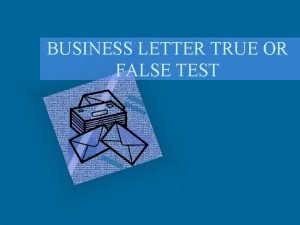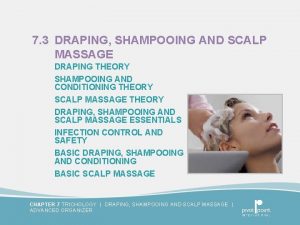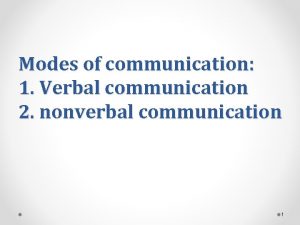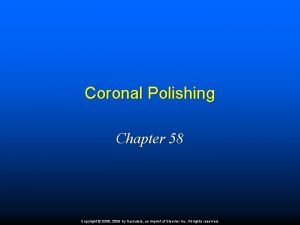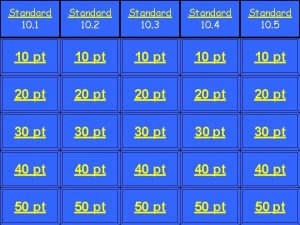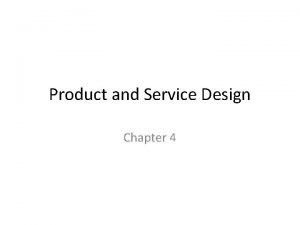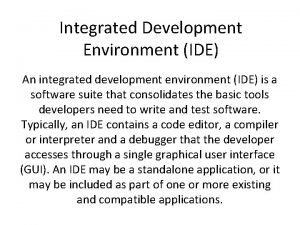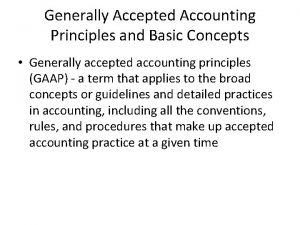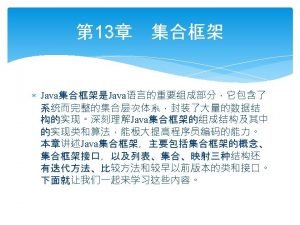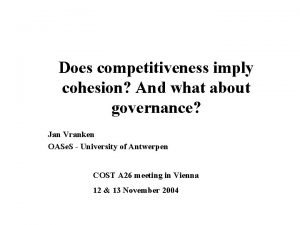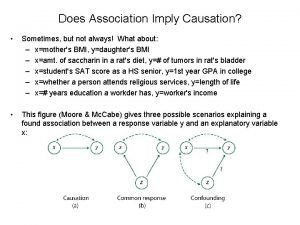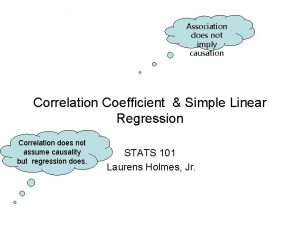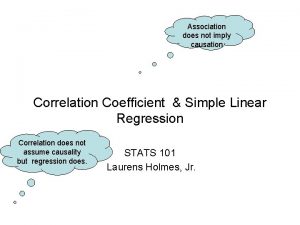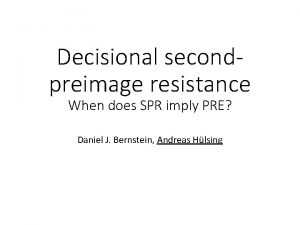SURVEY Introduction Survey generally imply a collection of















































- Slides: 47

SURVEY

Introduction Ø Survey generally imply a collection of facts and analysis, evaluation or interpretation of facts once they have collected and comparison of data from other times or places

Survey is defined as an investigation in which information is systematically collected, but in which there is no active intervention by the investigators.

Uses of survey 1. Monitoring trends in oral health and disease 2. Policy development 3. Program evaluation 4. Assessment of dental needs 5. Providing visibility for dental issues

Types of survey Ø Based on the design of the investigation 1. Descriptive 2. Analytic Ø It can also be classified as 1. Cross sectional 2. Longitudinal

Ø Based on the method of data collection 1. Health interview survey 2. Health examination survey 3. Health records survey 4. Questionnaire survey

Steps in survey 1. 2. 3. 4. 5. 6. 7. Establishing the objectives Designing the investigation Selecting the sample Conducting the examination Analysing the data Drawing the conclusion Publishing the results

Establishing the objectives Ø Purpose of the study Ø Hypothesis to be tested or disease to be measured 1.

2. Designing the investigation A. Descriptive B. Analytical ØCase control ØCohort (longitudinal)

3. Selecting the sample Sampling techniques

4. Conducting the examination Ø Due considerations to following aspects a) b) c) d) e) Examination methods and diagnostic aids Diagnostic criteria Indices Consent Selection of examiners

Examination methods and diagnostic aids Ø ADA classification of type of examination 1. 2. 3. 4. Type 1 - complete examination Type 2 - limited examination Type 3 -inspection Type 4 - screening

4. Conducting the examination Ø Due considerations to following aspects a) b) c) d) e) Examination methods and diagnostic aids Diagnostic criteria Indices Consent Selection of examiners

5. Analyzing the data Ø Calculation of percentage, means and standard deviation related to status and treatment needs is done as appropriate

Classification of treament needs (ADA) Ø Class 1 -requiring no dental treatment Ø Class 2 - requiring treatment but not of an emergency nature Ø Class 3 -requiring early treatment Ø Class 4 - emergency dental treatment Such as • Moderate calculus • Injuries Extensive advanced periodontal cases Prosthetic or cases • Acute Chronic oral pulpal infections or apical (periodontal infectionororadvanced Periodontal cases-not extensive • periapical Chronic oral abscesses, vincents infection, Corrective orinfection preventive measures • acute Surgical gingivitis, procedures stomatitis required etc. ) for removal of • Painful one or more conditions teeth not included in class 4

6. Drawing the conclusion

7. Publishing the results Report should include ØStatement of the purpose of the study ØMaterial and methods ØResults ØDiscussion and conclusion

Basic Oral Health Survey Ø Basic oral health surveys are used to collect information about the oral health status and treatment needs of a population, and subsequently, to monitor changes in levels and patterns of disease.

Can be used to determine: 1. existing oral health services 2. required preventive, curative and restora tive services. 3. The resources needed

Special characteristics of oral diseases 1. age-related 2. exist in all populations 3. Some diseases are irreversible 4. variation of profiles for population groups

Pathfinder surveys Ø It is a practical, economic survey sampling methodology Ø The method used is a stratified cluster sampling technique.

The method is suitable for obtaining the following information: Ø The overall prevalence. Ø Variations in disease level, severity and need for treatment Ø Age profiles of oral diseases in the population Ø About severity and progression of disease, and to give an indication as to whether the levels are increasing or decreasing.

Pathfinder surveys can be either 1. Pilot 2. National

ØA pilot survey is one that includes only the most important subgroups in the population and only one or two index ages, usually 12 years and one other age group.

ØA national pathfinder survey incorporates sufficient examination sites to cover all important subgroups of the population that may have differing disease levels or treatment needs, and at least three of the age groups or index ages

Subgroups Ø Sampling sites are usually chosen so as to provide information on population groups likely to have different levels of oral disease.

Index ages and age groups. Ø The following ages and age groups are recommended: 5 years for primary teeth and 12, 15, 35 -44 and 65 -74 years for permanent teeth.

Number of subjects. Ø The number of subjects in each index age group to be examined ranges from a minimum of 25 to 50 for each cluster or sampling site


Ø Survey Ø Uses of survey Ø Types of survey Ø Steps in survey Ø Basic oral health survey ØDesign of a Basic oral health survey ØOrganizing the survey ØTraining and calibration ØImplementing the survey

Organizing the Survey 1. Preparing a survey protocol 2. Obtaining approval from the authorities 3. Budgeting 4. Scheduling 5. Emergency care and referral 6. Courtesy reporting

1. Written protocol for the survey should contain the following information: Ø Main objective and purpose of the survey. Ø A description of the type of information to be collected and of the methods to be used. Ø A description of the sampling methods to be used. Ø Personnel and physical arrangements. Ø Statistical methods to be used in analyzing the data. Ø A provisional budget. Ø A provisional timetable of main activities and responsible staff.

2. Obtaining approval from the authorities Permission to examine population groups must be obtained from a local, regional or national authority.

3. Budgeting Ø all the resources required, including personnel, to carry out the survey

4. Scheduling Ø A basic examination of a child usually takes about 5 -10 minutes, while a complete examination of an adult may take be tween 15 and 20 minutes.

5. Emergency care and referral Ø A list of referral facilities and addresses should therefore be prepared before the survey

6. Courtesy reporting Ø It is appropriate, and often essential, to report the survey findings to local authorities.

Training and calibration Ø 2 1. 2. main reasons for the variability of clinical scoring Difficulty in scoring different levels of oral diseases Physical and psychological factors

Ø Objectives 1. 2. of standardization and calibration To ensure uniform interpretation, understanding and application by all examiners of the codes and criteria To ensure that each examiner can examine consistently

Ø Agreement for most assessments should be in the range of 85 -95% Ø Intra examiner reproducibility Ø Inter examiner reproducibility

Duplicate examination Ø 5 -10% of the sample(no less than 25)

Implementing the Survey 1. 2. 3. 4. General Personnel and organization Instruments and supplies Examination area

General Ø Contacts with persons in authority Ø Keeping a logbook Ø Preliminary exercise Ø Sources of fluorides

Personnel and organization Ø Recording clerk Ø Organizing clerk Ø Daily review of assessment forms

Instruments and supplies The following instruments and supplies are required for each examiner: Ø plane mouth mirrors Ø periodontal probes Ø several pairs of tweezers Ø containers (one for used instruments and one for sterilizing instru ments) and concentrated sterilizing solution Ø a wash basin (for either water and soap or disinfectant solution) Ø cloth or paper hand towels Ø gauze.

Examination area Ø Examination position Ø Lighting Ø Seating of recording clerk Ø Supply of survey forms Ø Avoidance of crowding Ø Avoidance of noise

Summary
 Landsat collection 1 vs collection 2
Landsat collection 1 vs collection 2 D/a 30 days
D/a 30 days Survey method of data collection
Survey method of data collection What is survey method
What is survey method What do this picture imply
What do this picture imply Does continuity imply differentiability
Does continuity imply differentiability What does the title imply
What does the title imply Efficient securities markets imply that
Efficient securities markets imply that What is the symbol of a round shape in the advent wreath?
What is the symbol of a round shape in the advent wreath? The galloping snail political cartoon analysis
The galloping snail political cartoon analysis When will the courts imply terms into a contract
When will the courts imply terms into a contract Nebulous in the great gatsby
Nebulous in the great gatsby What does the picture imply?
What does the picture imply? Who is macduff in macbeth
Who is macduff in macbeth Abcd in acls
Abcd in acls Lesson 3.1 introduction to data collection
Lesson 3.1 introduction to data collection Introduction of blood collection
Introduction of blood collection Introduction of collection of specimen
Introduction of collection of specimen Survey disclaimer example
Survey disclaimer example Introduction to a survey
Introduction to a survey Forecasting weather map worksheet #1
Forecasting weather map worksheet #1 Sound waves from a radio generally travel in which medium?
Sound waves from a radio generally travel in which medium? A prepositional phrase begins with a
A prepositional phrase begins with a In a minimum cardinality, minimums are generally stated as
In a minimum cardinality, minimums are generally stated as Relatively permanent
Relatively permanent Ashley began her banking career as a teller
Ashley began her banking career as a teller When to use comma before because
When to use comma before because Chaparral biomes are generally _______.
Chaparral biomes are generally _______. Which of the following is true of business letters?
Which of the following is true of business letters? An access matrix is generally dense
An access matrix is generally dense Client draping
Client draping What are finance companies
What are finance companies Culture that generally pursued by the upper class
Culture that generally pursued by the upper class Ingredients of art
Ingredients of art Generally restful,like the horizon,where the sky meets land
Generally restful,like the horizon,where the sky meets land Shapes that have smooth even edges and are measurable
Shapes that have smooth even edges and are measurable Generally, people use facial management techniques to
Generally, people use facial management techniques to Masculine characteristics
Masculine characteristics General accepted
General accepted It is generally refers to human movement
It is generally refers to human movement Chapter 58 coronal polishing
Chapter 58 coronal polishing At the end of the 1800s colonies were generally seen as a
At the end of the 1800s colonies were generally seen as a Differences between products and services
Differences between products and services Integrated development environment definition
Integrated development environment definition Scientifically minded people generally
Scientifically minded people generally The drug basket method is used to dispense
The drug basket method is used to dispense Free-hand notching
Free-hand notching Constraints of accounting principles
Constraints of accounting principles


